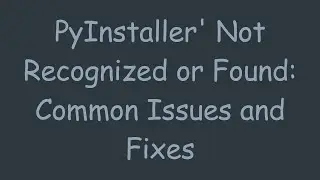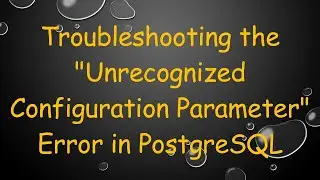Accessing Custom Settings in a Django Management Command
Learn how to access custom settings in a Django management command in a clear and efficient way.
---
Disclaimer/Disclosure: Some of the content was synthetically produced using various Generative AI (artificial intelligence) tools; so, there may be inaccuracies or misleading information present in the video. Please consider this before relying on the content to make any decisions or take any actions etc. If you still have any concerns, please feel free to write them in a comment. Thank you.
---
Accessing Custom Settings in a Django Management Command
In the Django web framework, management commands provide a way to extend the built-in Django command-line utilities. Whether it's for automating tasks, running maintenance scripts, or performing custom data migrations, management commands are indispensable. But what if you need to access custom settings that you have defined in your settings.py file while running these commands?
Here's a straightforward guide to achieving this.
Understanding Django Settings
Before diving into how to access custom settings in management commands, it's essential to know where these custom settings are typically defined. Django stores its project-wide settings in a module usually named settings.py. You can define your custom settings here like any other Django setting.
For instance:
[[See Video to Reveal this Text or Code Snippet]]
Creating a Management Command
First, you need to create a custom management command. Management commands are stored inside a Django application's management/commands directory.
Assuming you have an application named myapp, you can create your custom command as follows:
Inside your Django application directory (myapp), create the management/commands directories if they do not exist already.
Create a new Python file within this directory for your custom command, for example, my_command.py.
Your project structure should look something like:
[[See Video to Reveal this Text or Code Snippet]]
Accessing Custom Settings in the Command
Now, edit your my_command.py to include the necessary imports and define your command's functionality. To access custom settings, you'll use Django's settings object from django.conf.
Here is an example of how it can be done:
[[See Video to Reveal this Text or Code Snippet]]
In this example:
Import Required Modules: Import BaseCommand from django.core.management.base and settings from django.conf.
Define Your Command: Extend the BaseCommand class and define the handle method.
Access Your Custom Setting: Use getattr to fetch your custom setting from Django's settings module. If the setting does not exist, provide a default value (which is None in this case).
When you run your custom management command:
[[See Video to Reveal this Text or Code Snippet]]
The command will output the value of CUSTOM_SETTING if it is defined in your settings.py.
By efficiently accessing custom settings within your Django management command, you can leverage the full power of Django’s configuration system while keeping your commands flexible and reusable. This approach ensures maintainability and clarity, essential for any Django-based project.































